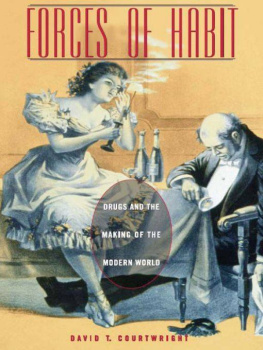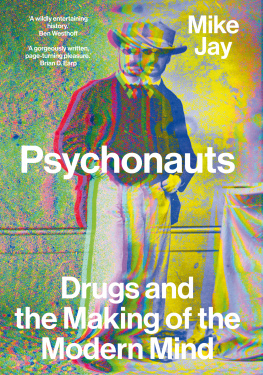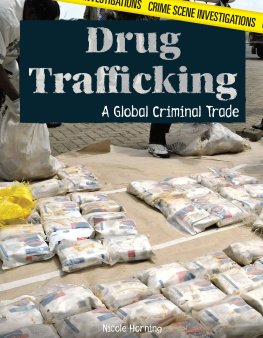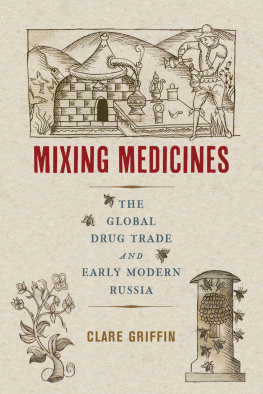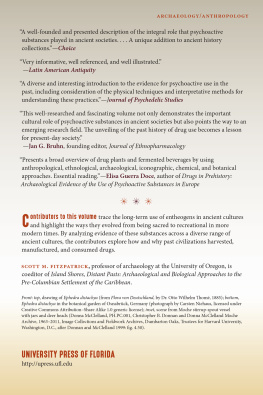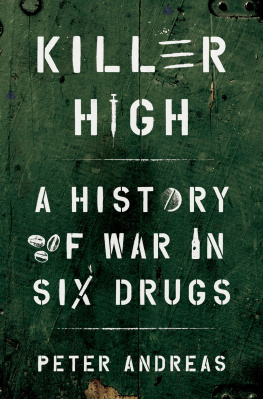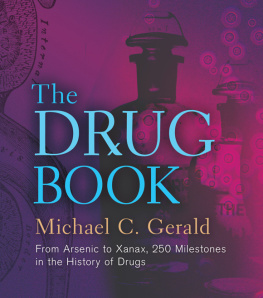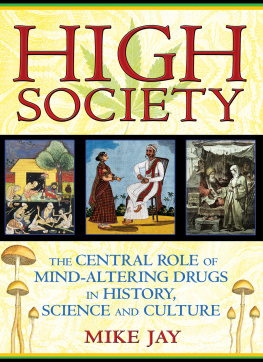Table of Contents
Copyright 2001 by the President and Fellows of Harvard College
All rights reserved
Printed in the United States of America
Third printing, 2002
First Harvard University Press paperback edition, 2002
Library of Congress Cataloging-in-Publication Data
Courtwright, David T., 1952
Forces of habit : drugs and the making of the modern world / David T. Courtwright.
p. cm.
Includes bibliographical references and index.
ISBN 0-674-00458-2 (cloth)
ISBN 0-674-01003-5 (pbk.)
1. Substance abuseHistory. 2. Psychotropic drugsHistory. 3. Substance abuseEconomic aspects. 4. Substance abuseSocial aspects. 5. Substance abusePrevention. I. Title.
HV4997 .C68 2000
362.29dc21 00-061466
To my brothers Chris and Mike, historians in their own unique ways
Acknowledgments
TEN YEARS AGO , while killing time between flights in a duty-free shop, I found myself wondering why I was surrounded by drugs. Marlboro cartons loomed to my left, Drambuie bottles to my right, Belgian chocolates behind me, Kenyan coffee straight aheadeverywhere I looked, I saw imported psychoactive products. How did these things get here? And why could here be anywherewhy did duty-free shops all seem to be stocked with the same merchandise? (Indeed, I can no longer recall which airport I was passing through.) Though I had long been interested in the history of narcotic drugs, this book grew out of a broader curiosity about psychoactive commerce, a ubiquitousand, I now believe, definingfeature of the modern world.
I could not have acted on that curiosity without a timely research leave from the University of North Florida and a fellowship from the National Endowment for the Humanities. The Francis C. Wood Institute for the History of Medicine supported my work at the College of Physicians of Philadelphia Library; the Sonnedecker Visiting Research Program financed a visit to the University of Wisconsin. Librarians there extended me every professional courtesy, as did those at the Universities of North Florida, Pennsylvania, and Kansas.
I am especially indebted to UNFs Alisa Craddock, who filled countless interlibrary loan requests, often cryptic and fiendishly obscure. Elaine Stroud, Greg Higby, and Glenn Sonnedecker offered assistance and advice during my stay in Madison. Charles Greifenstein, Marjorie Smink, Sophie Sereda, and Thomas Horrocks rendered similar services at the College of Physicians of Philadelphia. Deborah Franklin, editor of the Colleges Transactions, kindly granted permission to incorporate parts of my article, Medicines Problem Children, vol. 21, ser. 5 (1999): 59-86, into Chapter 4 of this book. At Duke University, Ellen Gartrell, Elizabeth Dunn, and Gary Boye steered me to valuable holdings in the Special Collections Library. Mort Goren, Rosemary Russo, Lavonne Wienke, Daphne Joseph, and Nora Beecher assisted me at (and often escorted me to) the Drug Enforcement Administration Library in Arlington, Virginia.
The editors and staff of Harvard University Pressparticularly Ada Donald, Elizabeth Suttell, Mary Ellen Geer, Tim Jones, and Sheila Barrettwere helpful and accommodating at every stage of the books development. Many scholars, colleagues, and students rendered assistance along the way. H. Wayne Morgan generously turned over research files to me. Dale Clifford, Jeffrey Kaimowitz, Bert Koegler, Kathryn Meyer, Debra Murphy, Shira Schwam-Baird, and John Tucker provided iconographic and translation advice. Rodney Brown, Andrew Courtwright, Janice Fluegel, Michael Hoffmann, Harold Hyman, Sam Kimball, William McAllister, Scott Martin and his seminar students, Shelby Miller, Stephen M. Miller, Ron Roizen, Wade Schemer, Susan Speaker, Kunisi Venkatasubban, and Linda Wilson read preliminary drafts of the manuscript, saving me from many errors and infelicities. Any that remain are stubbornly my own.
Introduction
THE PSYCHOACTIVE REVOLUTION
ON JULY 13 , 1926 , Anthony Colombo, a man of many habits, all of them bad, checked into the Philadelphia General Hospital. The staff assigned him to the drug warda good choice, considering that each day of his life he smoked a quarter-ounce of opium, puffed 80 cigarettes, drank two cups of coffee or tea, and downed a quart of whiskey. He got drunk nearly every day, he explained to an intern. He had begun smoking the opium to sober up.
But he didnt use the hard stuff. No cocaine. No barbiturates. No narcotics other than opiuma lie betrayed by his upper arms and thighs, pitted with the scars of hypodermic abscesses. Or perhaps it was a white lie. Opium smokers looked down on needle users in those days. Colombo had his pride to consider.
He was, after all, a working man. Addiction to opium had affected neither his will power, he boasted, nor his ability to work. He was in the liquor business, he saida striking admission from the citizen of a country that did not, in 1926, officially have a liquor business.
The opium habit did not affect his appetite, the intern noted. Just 33 years of age, Colombo tipped the scales at 275 pounds. The chest is immense, he wrote; the abdomen is large and pendulous. Considering Colombos weight, his three to five meals daily, his opium, his four score cigarettes, his coffee, his tea, and his whiskey, some form of gratification must have been passing through his mouth practically every waking moment. Indeed, Colombo led a lifeprobably not a long lifeof such continuous and varied stimulation and psychoactive pleasure that no emperor, no despot, no potentate of the ancient world, however wealthy, determined, or decadent, could have matched it.
Yet Anthony Colombo was a lowly man, a petty bootlegger of modest means. It was his luck, or misfortune, to live in the twentieth century, in an industrial city in an industrial nation that had, in its brief history, managed to refine and mass-market an impressive array of psychoactive pleasures. By the time Colombo checked into the hospital, millions of ordinary people throughout the world could lead, in neurochemical terms, a life-style unimaginable for even the wealthiest five hundred years earlier.
I call this development the psychoactive revolution. People everywhere have acquired progressively more, and more potent, means of altering their ordinary waking consciousness. One of the signal events of world history, this development had its roots in the transoceanic commerce and empire building of the early modern periodthat is, the years from about 1500 to 1789. Forces of Habit describes how early modern merchants, planters, and other imperial elites succeeded in bringing about the confluence of the worlds psychoactive resources and then explores why, despite enormous profits and tax revenues, their successors changed their minds and restricted or prohibited manybut not alldrugs.
The term drugs is an extremely problematic one, connoting such things as abuse and addiction. For all its baggage, the word has one great virtue. It is short. Indeed, one of the reasons its use persisted, over the objections of offended pharmacists, was that headline writers needed something pithier than narcotic drugs. In this book I use drugs as a convenient and neutral term of reference for a long list of psychoactive substances, licit or illicit, mild or potent, deployed for medical and nonmedical purposes. Alcoholic and caffeinated beverages, cannabis, coca, cocaine, opium, morphine, and tobacco are all drugs in this sense, as are heroin, methamphetamine, and many other semisynthetic and synthetic substances. None is inherently evil. All can be abused. All are sources of profit. All have become, or at least have the potential to become, global commodities.

